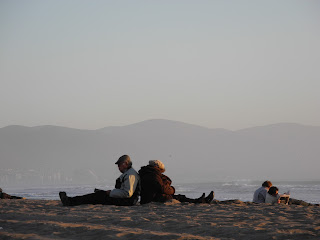For the next month, I'll be living in La Serena, a town about 6 hours north of Santiago. La Serena is the capital city of the Coquimbo region, which is home to some of the biggest and most influential observatories in modern Astronomy, including Gemini South, SOAR and NOAO South, to name a few. The
LSST (Large Synoptic Survey Telescope) -- which is a HUGE deal for astronomy -- is also being built here. In addition to these well-known scientific instruments, La Serena is also home to many "tourist" observatories designed specifically for public outreach. While I'm here, I hope to visit as many scientific and tourist observatories as possible to try to understand if the proximity to these powerful instruments influences children's understanding of the Universe.
In La Serena, I'm living on the compound of AURA, the umbrella organization of all of the major scientific observatories in Coquimbo. The compound is on a hill above the city, and is a bit of an Americanized bubble. My house has American plugs and appliances and most of the signs are in English. The observatories are funded by the US government and the compound (
el recinto) was built this way back when it was still very far from La Serena, and was primarily occupied by American scientists here for observing runs. Now, La Serena is bigger, and more permanent staff occupy the houses on the hill.
 |
| View from the top of the hill. You can see La Serena below and the ocean glistening in the distance. |
Settling in here has been a shift from my time in Santiago. My house is quiet (there's one other student living with me, although she's currently on a long vacation), and a trip to the grocery store involves a long walk there, and a longer, more strenuous walk back up the hill. But it's beautiful here, and I can see the stars at night much better than in the center of the city. I even took my first real star photo! It's not very good, probably due to some limitations on my camera. But you can see some stars, as well as the light pollution from the city below...
Last week, I met with Leonor Opazo, one of the outreach people I'll be working with while I'm here. She gave me a great presentation on the work CTIO (Cerro Tololo Inter-American Observatory) does, the resources they have, and also the limitations in their outreach capabilities. They do a LOT of activities with kids and teachers locally and all over Chile, and I'll be tagging along on as many activities as I can while I'm here.
On Saturday, Leonor organized for me to go up to the observatory itself for a day trip. Every Saturday, they give observatory tours for free, although the trek up there can be expensive. Also, the tours get booked very quickly and people often have to reserve spots months in advance. As a "guest of the observatory" I got to ride up with the tour guides directly from my neighborhood and spend the whole day there. Pictures of the telescopes:
 |
| 1.5m telescope + school group |
 |
| 4 m telescope under construction to install DECam, to investigate and "survey" Dark Energy |
|
And pictures of the natural world surrounding the telescopes:
 |
| mountain rabbit |
 |
| two fox who hang out by the cafeteria |
I had an AWESOME day. It was overcast when we left La Serena, and it was phenomenal driving through the clouds and into the sunny mountains. When we first arrived, it looked like there was an ocean of clouds right below us.
Kadur, the tour guide, was especially accommodating and took me to all the best areas around the observatories. I went on his morning tour, which was entirely in Spanish, and understood (almost) all of it! In the afternoon, I walked around the premises and enjoyed the landscape while talking with observatory staff, also in Spanish. My language skills definitely improve every day I'm here, I just wonder sometimes if I'll ever be able to understand full-speed Chilean Spanish.
The rest of my time here has been spent exploring La Serena. On the morning observatory tour on Saturday, I met Australian Kimberley and British Sarah, who were in La Serena together from Santiago. I tagged along on their weekend plans and had a nice time exploring and enjoying the sunny beach with them on Sunday. Pictures from my adventures both with them and solo:
This week I look forward to meeting more of the outreach team and getting started with activities! While I talked briefly with some kids at the observatory on Saturday, I look forward to having more structured time to delve into the heart of my project.



















































